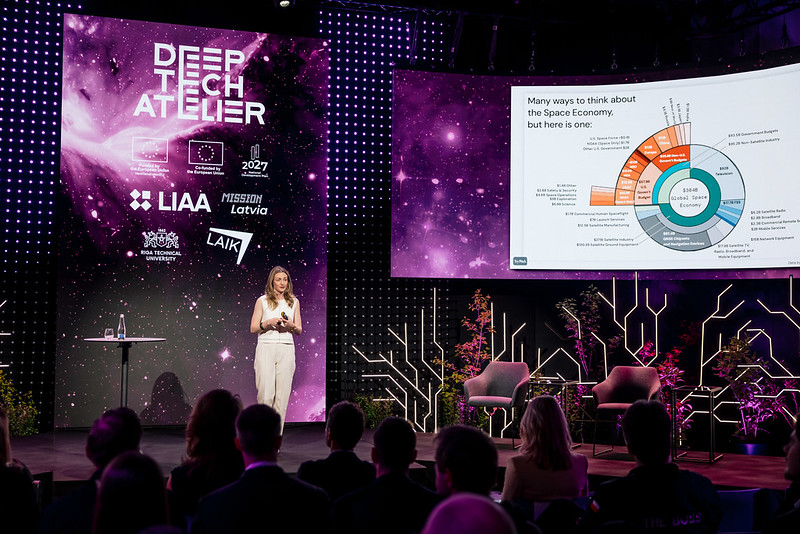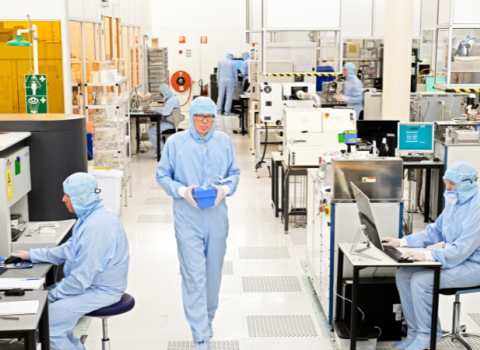Latvian startups are innovating across many different aspects of space technology

Latvian president opening the Deep Tech Atelier 2025
Latvia may not be the first country that comes to mind when one thinks about the space industry, but in recent years Latvian deep-tech startups have become important partners of the European Space Agency (ESA).
One of the most prominent examples is Eventech, a spin-off from the Latvian Institute of Electronics and Computer Science specialising in precision electronic measuring devices. Its product Event Timer A033-ET has received acclaim from NASA’s International Laser Ranging Service.
For several years, space technology has been a key theme at Deep Tech Atelier, the largest event in the Baltic deep-tech ecosystem. This is not surprising as, according to Bryce Tech, the global space economy is worth aboutUS$384 billion, Sinead O’Sullivan, professor of aerospace engineering at the Illinois Institute of Technology, said during her presentation at Deep Tech Atelier 2025, which was held in May in Riga.
From precision measurement and image processing to 3D printing, hydrogen technology and power supply, Latvian deep-tech companies are both helping solve complex space challenges and laying the foundations for sustainable and forward-looking industrial development. Below are some examples of the Latvian space tech companies, some of them one was able to meet at Deep Tech Atelier:
NRG Solutions
The first company selected to participate in the ESA’s Business Incubation Centre in Latvia, NRG Solutions uses Earth observation data for property valuation and assessment. The company’s solution offers data-driven insights by identifying structural and environmental factors that affect the condition of buildings, a more objective and efficient alternative to traditional methods.
Bitlake Technologies
Bitlake Technologies specialises in the development of digital microchip components (IP cores) for FPGAs (field programmable gate arrays) used for image processing and computer vision in space-based applications. In simple terms, these modules ensure fast and efficient image processing in real time, which means that, for example, an image captured by a satellite is analysed immediately, without having to transmit huge amounts of data back to Earth.
This technology can be used in a number of ways, including for object detection (for example, to monitor for obstacles or debris in orbit), image recognition and other purposes in space where fast and reliable image processing is needed.
2AM
The Latvian company 2AM has created innovative aluminium, magnesium and scandium alloys and metal matrix nanocomposites tailored specifically for 3D metal printing in aerospace applications. These materials combine lightweight and high strength, enabling production of large, but lightweight structures that are essential for both the space and aviation industries. The main challenge that this innovation addresses is the need for reliable and efficient materials that can withstand the extremes of space.
Naco Technologies
Green hydrogen startup Naco Technologies is developing nano-coatings that protect system components from corrosion to improve their durability. The technology could be essential for the future of sustainable energy. The company’s solutions will increase durability while reducing the weight and size of fuel cell systems, especially those used in Earth-based space applications. Naco Technologies is now developing nano-coating catalysts for fuel cell membranes.
Deep Space Energy
Deep Space Energy is on a mission to become an electricity supplier in space powering exploration, industry and living beyond Earth. The company develops early-stage technologies to cover various space energy generation assets, such as advanced solar technologies, radioisotope electric generators, hydrogen storage and nuclear fission power.
Nanocraft
Through a collaboration between Nanocraft, Ventspils University of Applied Sciences, and Tartu Observatory, photorealistic modelling project CI3D was presented to the European Space Agency for testing the Comet Interception mission’s cameras.
Nanocraft technology can combine data from different instruments into a single 3D model so that scientists can analyse comets’ structure and behaviour in detail. This approach ensures more precise mission planning and increases the likelihood of obtaining valuable scientific data.
The aim of the Comet Interceptor mission is to study, for the first time, a comet that comes from the outer limits of the Solar System and has not been exposed to the effects of the Sun before. These 3D models help simulate comet movement patterns and analyse possible risks, such as collisions with dust particles.

The Deep Tech Atelier conference was held for the seventh time in 2025 and was the largest to date with more than 2,000 attendees from 62 countries. Dates have already been set for Deep Tech Atelier 2026 in Riga: 14 and 15 May.
The event funding is provided by the ERDF projects “Development of Innovative Entrepreneurship of SMEs” and “Support for Improving Technology Transfer System”, the Recovery and Resilience Facility, and the state budget.
The views and opinions expressed are those of the author(s) alone and do not necessarily reflect the opinion of the European Union or the European Commission. Neither the European Union nor the European Commission is responsible for these views and opinions.





 A unique international forum for public research organisations and companies to connect their external engagement with strategic interests around their R&D system.
A unique international forum for public research organisations and companies to connect their external engagement with strategic interests around their R&D system.